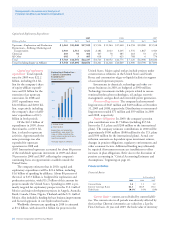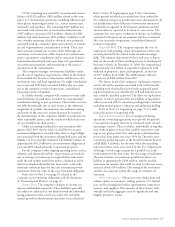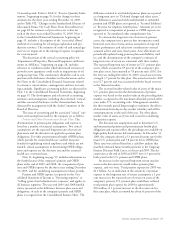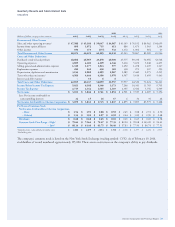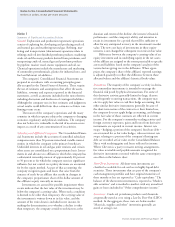Chevron 2009 Annual Report Download - page 31
Download and view the complete annual report
Please find page 31 of the 2009 Chevron annual report below. You can navigate through the pages in the report by either clicking on the pages listed below, or by using the keyword search tool below to find specific information within the annual report.Chevron Corporation 2009 Annual Report 29
FS-PB
Investments in common stock of affiliates that are
accounted for under the equity method, as well as invest-
ments in other securities of these equity investees, are
reviewed for impairment when the fair value of the invest-
ment falls below the company’s carrying value. When such a
decline is deemed to be other than temporary, an impairment
charge is recorded to the income statement for the difference
between the investment’s carrying value and its estimated fair
value at the time.
In making the determination as to whether a decline is
other than temporary, the company considers such factors as
the duration and extent of the decline, the investee’s finan-
cial performance, and the company’s ability and intention
to retain its investment for a period that will be sufficient to
allow for any anticipated recovery in the investment’s mar-
ket value. Differing assumptions could affect whether an
investment is impaired in any period or the amount of the
impairment, and are not subject to sensitivity analysis.
From time to time, the company performs impairment
reviews and determines whether any write-down in the carry-
ing value of an asset or asset group is required. For example,
when significant downward revisions to crude-oil and
natural-gas reserves are made for any single field or conces-
sion, an impairment review is performed to determine if the
carrying value of the asset remains recoverable. Also, if the
expectation of sale of a particular asset or asset group in any
period has been deemed more likely than not, an impairment
review is performed, and if the estimated net proceeds exceed
the carrying value of the asset or asset group, no impairment
charge is required. Such calculations are reviewed each period
until the asset or asset group is disposed of. Assets that are
not impaired on a held-and-used basis could possibly become
impaired if a decision is made to sell such assets. That is, the
assets would be impaired if they are classified as held-for-sale
and the estimated proceeds from the sale, less costs to sell,
are less than the assets’ associated carrying values.
Goodwill Goodwill resulting from a business combina-
tion is not subject to amortization. As required by accounting
standards for goodwill (ASC 350), the company tests such
goodwill at the reporting unit level for impairment on an
annual basis and between annual tests if an event occurs or
circumstances change that would more likely than not reduce
the fair value of a reporting unit below its carrying amount.
Contingent Losses Management also makes judgments
and estimates in recording liabilities for claims, litigation,
tax matters and environmental remediation. Actual costs can
frequently vary from estimates for a variety of reasons. For
example, the costs from settlement of claims and litigation
can vary from estimates based on differing interpretations
of laws, opinions on culpability and assessments on the
amount of damages. Similarly, liabilities for environmental
remediation are subject to change because of changes in laws,
regulations and their interpretation, the determination of
additional information on the extent and nature of site con-
tamination, and improvements in technology.
Under the accounting rules, a liability is generally
recorded for these types of contingencies if management
determines the loss to be both probable and estimable.
The company generally reports these losses as “Operating
expenses” or “Selling, general and administrative expenses”
on the Consolidated Statement of Income. An exception to
this handling is for income tax matters, for which benefits are
recognized only if management determines the tax position
is “more likely than not” (i.e., likelihood greater than 50 per-
cent) to be allowed by the tax jurisdiction. For additional
discussion of income tax uncertainties, refer to Note 15
beginning on page 53. Refer also to the business segment
discussions elsewhere in this section for the effect on earnings
from losses associated with certain litigation, environmen-
tal remediation and tax matters for the three years ended
December 31, 2009.
An estimate as to the sensitivity to earnings for these
periods if other assumptions had been used in recording
these liabilities is not practicable because of the number of
contingencies that must be assessed, the number of underly-
ing assumptions and the wide range of reasonably possible
outcomes, both in terms of the probability of loss and the
estimates of such loss.
New Accounting Standards
The FASB Accounting Standards Codification and the
Hierarchy of Generally Accepted Accounting Principles – a
replacement of FASB Statement No. 162 (FAS 168) In June
2009, the FASB issued FAS 168, which became effective
for the company in the quarter ending September 30, 2009.
This standard established the FASB Accounting Standards
Codification (ASC) system as the single authoritative source
of U.S. generally accepted accounting principles (GAAP) and
superseded existing literature of the FASB, Emerging Issues
Task Force, American Institute of CPAs and other sources.
The ASC did not change GAAP, but organized the literature
into about 90 accounting Topics. Adoption of the ASC did
not affect the company’s accounting.
Employer’s Disclosures About Postretirement Benefit Plan
Assets (FSP FAS 132(R)-1) In December 2008, the FASB
issued FSP FAS 132(R)-1, which was subsequently codified
into ASC 715, Compensation – Retirement Benefits, and became
effective with the company’s reporting at December 31, 2009.
This standard amended and expanded the disclosure require-
ments for the plan assets of defined benefit pension and other
postretirement plans. Refer to information beginning on page
59 in Note 21, Employee Benefits, for these disclosures.
Transfers and Servicing (ASC 860), Accounting for Trans-
fers of Financial Assets (ASU 2009-16) The FASB issued
ASU 2009-16 in December 2009. This standard became
effective for the company on January 1, 2010. ASU 2009-16



